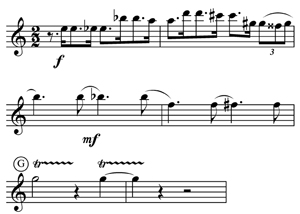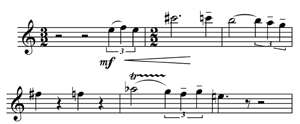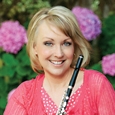Paul Hindemith (1895-1963) is one of the most important composers of the 20th century. He wrote in a variety of genres from chamber music to orchestral and everything in between. He composed scores for opera and ballet, in addition to writing masterworks for the concert band. Hindemith also wrote at least one solo sonata for each instrument of the orchestra: strings, brass, and woodwinds alike. His Flute Sonata has become a cornerstone of the repertory, and it is rare to find a student who has not studied this work by the time they have an undergraduate degree.
The Symphony in Bb for Band was composed at the request of Lt. Colonel Hugh Curry, conductor of the U. S. Army Band, also known as “Pershing’s Own.” The piece was premiered on April 5, 1951 with Hindemith conducting. It is a fine demonstration of Hindemith’s unique tonal but non-diatonic approach to harmony: for example, the printed parts are littered with accidentals but do not include key signatures. Each movement has masterful examples of counterpoint and explores the timbres available in wind band scoring beautifully.
The composition is written in three movements and is scored for flutes 1 and 2 plus a separate piccolo part. The first movement, marked ‘Moderately fast, with vigor’, has some very transparent writing for piccolo from letters B to D. The solos in measure 33-34 should be at a piano dynamic but played in a rather firm style without a lot of romantic tapering in this little motive.

The passagework that follows in measures 42-50 is in answer to the flutes initial motive: play with a dynamic that matches the flutes exactly and use a crisp buoyant articulation.

The soli passage beginning in measure 92 is in unison with the flutes. Subdivide carefully so that the rhythm is very crisp. The trill at letter G should be brilliant. It will help to curve the pinky finger because a bent finger is more relaxed and moves fast more easily.

The second movement, Andantino Grazioso, becomes restless about half way through, where it goes into a much faster tempo, dotted-quarter =112, marked fast and gay.
The passage at measure 27 functions as an ornamental counterpoint to a saxophone solo and is in rhythmical unison with the flutes. The dotted eighth notes should be quite short. Make sure that the 16th-note pick-ups remain true 16ths and don’t lapse into a triplet feel.

The rhythmic passages at measures 72-76 and from measure 112 to 116 are a bit tricky. Hang onto your own patterns. The flutes have 16th-note passages that overlap with your motives. This is another example of the rhythmic layers that Hindemith uses throughout the work. The short solo at measure 99 should be played softly. You might consider using the F-G trill fingering on the repeated notes here.
The third movement is a Fugue and is marked ‘rather broad’. Fragments of the theme can be heard throughout. Keep the scherzando at E and J very soft and blend with the oboe and flute colors. Make sure that the quarter notes are full value. The tone in the passage at measure 98 should have a dolce quality; it is doubled with the flutes.

There is a separate Errata sheet that accompanies the score that was complied by Tim Topolewski. It includes one correction for the piccolo part. In the third movement, measure 212, the first eighth note should be a C n , not a Cb. This correction was already made in the set of parts that I have (Schott, 1951, revised 1979), but I suspect that the error remains on the older, originally published set of parts.
The Symphony in Bb for Band is a cornerstone of the literature for wind ensemble. It is colorful and very exciting to play as well as to listen to. Hindemith uses the piccolo in a very comfortable range most of the time. There are only a few measures written in the third octave, so performers can concentrate on refining their middle register tone by working on this ensemble piece.






